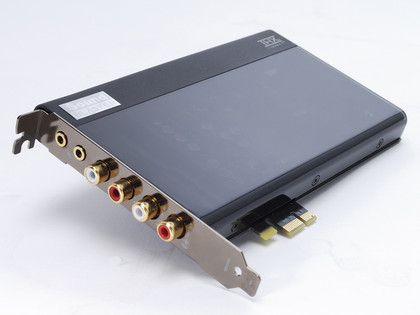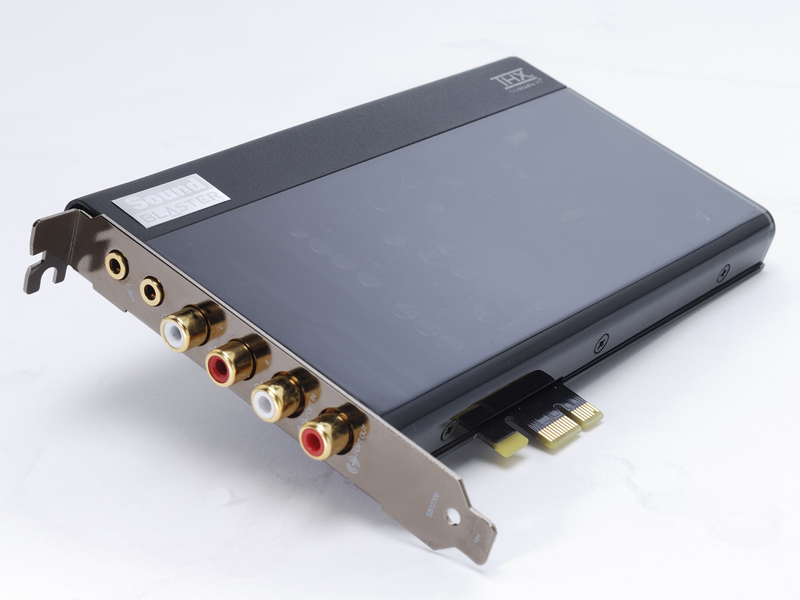Why you can trust TechRadar

You've got to be really interested in PC audio to even consider buying a sound card for over £160, and the X-Fi Titanium HD has a couple of other quirks to keep the riff-raff at bay too.
For example, round the back of the card, there's a 3.5mm headphone out and mic in, but the four RCA ports could be very controversial.
Two are for stereo line out, two are for stereo line in, which means if you want surround sound, you're going to have to use the optical connection to a separate amp and decoder, rather nullifying your investment in a high quality on-board one. There are no analogue connections for surround speakers.
That's a design quirk we can live with. After all, the audience for the Titanium HD is probably more interested in the low latency ASIO drivers for professional studio recording than listening for someone creeping up behind them in Call of Duty 4.
But what of the actual sound quality? Technically, according to the Rightmark Audio Analyzer benchmark, it comes close enough to the specs on the box to run rings around a standard Realtek on-board chip, although it loses out to Asus' Xonar Xense – a card very similar to the £150 Xonar Essence STX.
Subjectively, the tone is infinitely tuneable, but by default the card puts out a warm, rich sound in movies which – being critical – needs a little more emphasis on the higher frequencies for listening to music through headphones.
Gaming wise, even though on-board sound has come a long way, you will still notice the difference if you upgrade to an add-in card like this.
The trouble for the X-Fi Titanium HD is that for most people it's just not that much better than, say, the X-Fi Xtreme Gamer, which is a quarter of the price.
And if you really have to buy something that can edit out only the differences dogs can hear, then Asus' Xonar Xense is only £30 more expensive, but comes with a pair of Sennheiser headphones worth half the price, and a more impressive headphone amp to power them.
Auzentech's X-Fi Bravura, meanwhile, comes perilously close to the Titanium HD's specs, but costs just £70.
We're not arguing that you shouldn't pay for quality, but it's hard to imagine anyone who wouldn't be better off upgrading their headphones or speakers, or silencing their PC, than spending nearly £200 on a sound card.
We liked:
Even with the improvements in on-board sound, there's still a place for add-in cards, whether you're gaming, watching movies or listening to tunes. The X-Fi Titanium HD has some impressive specs that appeal to audio purists.
We disliked:
It's just too niche, and too expensive. You could easily argue, for example, that any improvement in sound quality over a cheaper card using the same chip is going to be drowned out by the noise of your PSU.
If you want this kind of audio quality, you're probably not using your PC as your main entertainment device.
Verdict:
Even with the improvements in on-board sound, there's still a place for add-in cards whether you're gaming, watching movies or listening to tunes.
The X-Fi Titanium HD has some impressive specs that appeal to audio purists. A fair shot at the high end, but other hi-fi cards are cheaper and better.
Follow TechRadar Reviews on Twitter: http://twitter.com/techradarreview
Current page: Creative X-Fi Titanium HD: Verdict
Prev Page Creative X-Fi Titanium HD: BenchmarksDan (Twitter, Google+) is TechRadar's Former Deputy Editor and is now in charge at our sister site T3.com. Covering all things computing, internet and mobile he's a seasoned regular at major tech shows such as CES, IFA and Mobile World Congress. Dan has also been a tech expert for many outlets including BBC Radio 4, 5Live and the World Service, The Sun and ITV News.
